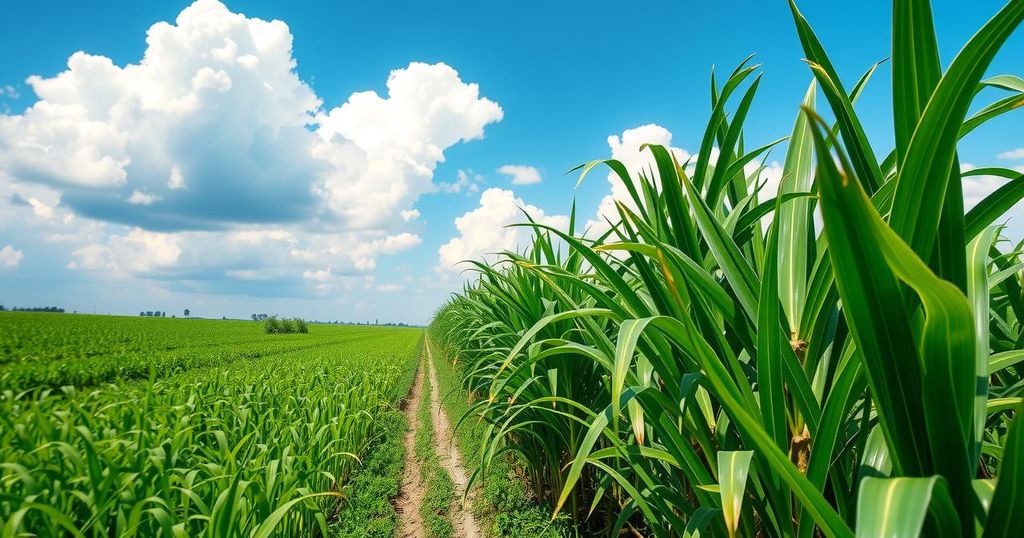Sugar prices have decreased due to rain forecasts for Brazil, which eased dryness concerns, and a weaker Brazilian real supporting export activity. This follows recent highs in sugar prices attributable to lower global production estimates. Forecasts suggest both tightening markets and increased production in several regions, indicating ongoing fluctuations in the sugar sector.
Sugar prices have recently decreased, with May New York world sugar 11 (SBK25) down by 0.15 cents, or 0.79%, and May London ICE white sugar 5 (SWK25) down by 1.90 cents, or 0.35%. This decline marks a continuation of the downward trend, attributed to favorable rain forecasts for Brazil’s sugar-growing regions that have alleviated previous drought concerns. Meteorologist Climatempo anticipates widespread rainfall extending into the next week.
The Brazilian real has experienced a drop to a two-week low, further contributing to the decline in sugar prices. A weaker real tends to promote export selling by Brazilian sugar producers, thereby influencing market prices adversely. This follows a previous rise in sugar prices, where New York sugar reached a one-month high and London sugar hit a four-month high due to indications of diminishing global sugar production.
On March 12, the Indian Sugar and Bio-energy Manufacturers Association revised its projection for India’s 2024/25 sugar production down to 26.4 million metric tons (MMT), a significant reduction from an earlier estimate of 27.27 MMT, primarily due to lower cane yields. Concurrently, Unica reported a 5.3% year-over-year decline in Brazil’s Center-South sugar output, which amounted to 39.983 MMT through mid-March.
Additionally, the International Sugar Organization raised its forecast for the global sugar deficit in 2024/25 to 4.88 MMT from 2.51 MMT forecasted in November. It also lowered the global sugar production forecast to 175.5 MMT, showcasing a tightening market compared to the surplus of 1.31 MMT anticipated for the 2023/24 season.
On a bearish note, consultant Datagro has predicted a 6% rise in Brazil’s Center-South sugar production for 2025/26, estimating it would reach 42.4 MMT. Green Pool Commodity Specialists have also indicated that the global sugar market may transition from a deficit of 3.7 MMT in 2024/25 to a surplus of 2.7 MMT by the 2025/26 crop year.
The Indian government has recently eased restrictions on sugar exports, permitting mills to export 1 MMT this season, lifted from previous limitations that aimed to sustain sufficient domestic supply. India previously limited exports to 6.1 MMT in the 2022/23 season. Notably, the India Sugar Mills Association anticipates production to decline to a five-year low of 26.4 MMT in 2024/25, a 17.5% drop year-over-year.
Moreover, positive production outlooks from Thailand are likely to exert downward pressure on sugar prices. Thailand’s Office of the Cane and Sugar Board has projected a significant increase of 18% year-on-year for its 2024/25 sugar production, reaching approximately 10.35 MMT, following the previous year’s output of 8.77 MMT. As the world’s third-largest sugar producer, Thailand’s larger supply could impact global pricing.
The drought and extreme heat experienced last year resulted in significant agricultural damage, particularly in Brazil’s Sao Paulo state, affecting sugar crops. Green Pool Commodity Specialists have noted potential losses of up to 5 MMT of sugar cane attributable to fires. Conab, Brazil’s national crop forecasting organization, has adjusted its estimate for 2024/25 Brazil sugar production down to 44 MMT due to lower yields from these adverse conditions.
The USDA’s bi-annual report published in late November forecasted a 1.5% increase in global sugar production for 2024/25, projecting record levels of 186.619 MMT. Concurrently, human sugar consumption is expected to rise by 1.2% to a new peak of 179.63 MMT, with ensuing declines in global sugar ending stocks by 6.1% to 45.427 MMT.
In summary, sugar prices have seen a notable decline due to beneficial weather forecasts for Brazil, leading to eased dryness concerns, and a depreciation of the Brazilian real, which enhances the competitiveness of exports. While there are optimistic projections for sugar production in Brazil and Thailand, a tightening global market is anticipated for the upcoming years. These developments underline the complex dynamics influencing sugar pricing, which merit close observation as they evolve.
Original Source: www.tradingview.com






